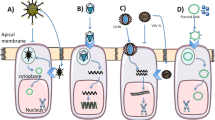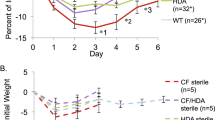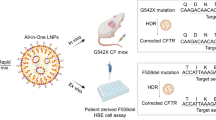Abstract
In cystic fibrosis (CF), respiratory failure caused by progressive airway obstruction and tissue damage is primarily a result of the aberrant inflammatory responses to lung infections with Pseudomonas aeruginosa. Despite considerable improvement in patient survival, conventional therapies are mainly supportive. Recent progress toward gene therapy for CF has been encouraging; however, several factors such as immune response and transduced cell turnover remain as potential limitations to CF gene therapy. As alternative gene therapy vectors for CF, we examined the feasibility of using recombinant SV40-derived vectors (rSV40s), which may circumvent some of these obstacles. To accommodate the large cystic fibrosis transmembrane conductance regulator (CFTR) cDNA, we removed not only SV40 Tag genes, but also all capsid genes. We, therefore, tested whether ‘gutless’ rSV40s could be packaged and were able to express a functional human CFTR cDNA. The results from our in vitro analysis determined that rSV40–CFTR was able to successfully result in the expression of CFTR protein, which localized to the plasma membrane and restored channel function to CFTR-deficient cells. Similarly, in vivo experiments delivering rSV40–CFTR to the lungs of Cftr−/− mice resulted in a reduction of the pathology associated with intra-tracheal P. aeruginosa challenge. rSV40–CFTR-treated mice had less weight loss when compared with control-treated mice as well as demonstrably reduced lung inflammation as evidence by histology and reduced inflammatory cytokines in the broncho-alveolar lavage. The reduction in inflammatory cytokine levels led to an evident decrease in neutrophil influx to the airways. These results indicate that further study of the application of rSV40–CFTR to CF gene therapy is warranted.
This is a preview of subscription content, access via your institution
Access options
Subscribe to this journal
Receive 12 print issues and online access
$259.00 per year
only $21.58 per issue
Buy this article
- Purchase on Springer Link
- Instant access to full article PDF
Prices may be subject to local taxes which are calculated during checkout










Similar content being viewed by others
References
Schwiebert EM, Benos DJ, Fuller CM . Cystic fibrosis: a multiple exocrinopathy caused by dysfunctions in a multifunctional transport protein. Am J Med 1998; 104: 576–590.
Southern KW . delta F508 in cystic fibrosis: willing but not able. Arch Dis Child 1997; 76: 278–282.
Flotte TR . Gene therapy progress and prospects: recombinant adeno-associated virus (rAAV) vectors. Gene Therapy 2004; 11: 805–810.
Ferrari S, Geddes DM, Alton EW . Barriers to and new approaches for gene therapy and gene delivery in cystic fibrosis. Adv Drug Deliv Rev 2002; 54: 1373–1393.
Driskell RA, Engelhardt JF . Current status of gene therapy for inherited lung diseases. Annu Rev Physiol 2003; 65: 585–612.
Griesenbach U, Ferrari S, Geddes DM, Alton EW . Gene therapy progress and prospects: cystic fibrosis. Gene Therapy 2002; 9: 1344–1350.
Flotte TR . Recombinant adeno-associated virus vectors for cystic fibrosis gene therapy. Curr Opin Mol Ther 2001; 3: 497–502.
Mueller C, Flotte TR . Gene therapy for cystic fibrosis. Clin Rev Allergy Immunol 2008; 35: 164–178.
Harvey BG, Leopold PL, Hackett NR, Grasso TM, Williams PM, Tucker AL et al. Airway epithelial CFTR mRNA expression in cystic fibrosis patients after repetitive administration of a recombinant adenovirus. J Clin Invest 1999; 104: 1245–1255.
Virella-Lowell I, Poirier A, Chesnut KA, Brantly M, Flotte TR . Inhibition of recombinant adeno-associated virus (rAAV) transduction by bronchial secretions from cystic fibrosis patients. Gene Therapy 2000; 7: 1783–1789.
Zeitlin PL . Cystic fibrosis gene therapy trials and tribulations. Mol Ther 2000; 1: 5–6.
Strayer D, Branco F, Zern MA, Yam P, Calarota SA, Nichols CN et al. Durability of transgene expression and vector integration: recombinant SV40-derived gene therapy vectors. Mol Ther 2002; 6: 227–237.
Strayer DS, Zern MA, Chowdhury JR . What can SV40-derived vectors do for gene therapy? Curr Opin Mol Ther 2002; 4: 313–323.
Norkin LC . Simian virus 40 infection via MHC class I molecules and caveolae. Immunol Rev 1999; 168: 13–22.
Pelkmans L, Puntener D, Helenius A . Local actin polymerization and dynamin recruitment in SV40-induced internalization of caveolae. Science 2002; 296: 535–539.
Kondo R, Feitelson MA, Strayer DS . Use of SV40 to immunize against hepatitis B surface antigen: implications for the use of SV40 for gene transduction and its use as an immunizing agent. Gene Therapy 1998; 5: 575–582.
Strayer DS, Lamothe M, Wei D, Milano J, Kondo R . Generation of recombinant SV40 vectors for gene transfer. Methods Mol Biol 2001; 165: 103–117.
Schoumacher RA, Ram J, Iannuzzi MC, Bradbury NA, Wallace RW, Hon CT et al. A cystic fibrosis pancreatic adenocarcinoma cell line. Proc Natl Acad Sci USA 1990; 87: 4012–4016.
Egan ME, Glockner-Pagel J, Ambrose C, Cahill PA, Pappoe L, Balamuth N et al. Calcium-pump inhibitors induce functional surface expression of Delta F508-CFTR protein in cystic fibrosis epithelial cells. Nat Med 2002; 8: 485–492.
West MR, Molloy CR . A microplate assay measuring chloride ion channel activity. Anal Biochem 1996; 241: 51–58.
Heeckeren A, Walenga R, Konstan MW, Bonfield T, Davis PB, Ferkol T . Excessive inflammatory response of cystic fibrosis mice to bronchopulmonary infection with Pseudomonas aeruginosa. J Clin Invest 1997; 100: 2810–2815.
Sirninger J, Muller C, Braag S, Tang Q, Yue H, Detrisac C et al. Functional characterization of a recombinant adeno-associated virus 5-pseudotyped cystic fibrosis transmembrane conductance regulator vector. Hum Gene Ther 2004; 15: 832–841.
Dajani R, Zhang Y, Taft PJ, Travis SM, Starner TD, Olsen A et al. Lysozyme secretion by submucosal glands protects the airway from bacterial infection. Am J Respir Cell Mol Biol 2005; 32: 548–552.
Akinbi HT, Epaud R, Bhatt H, Weaver TE . Bacterial killing is enhanced by expression of lysozyme in the lungs of transgenic mice. J Immunol 2000; 165: 5760–5766.
Wiley SR, Kraus RJ, Zuo F, Murray EE, Loritz K, Mertz JE . SV40 early-to-late switch involves titration of cellular transcriptional repressors. Genes Dev 1993; 7: 2206–2219.
Pasyk EA, Foskett JK . Mutant (delta F508) cystic fibrosis transmembrane conductance regulator Cl- channel is functional when retained in endoplasmic reticulum of mammalian cells. J Biol Chem 1995; 270: 12347–12350.
Johnson LG, Olsen JC, Sarkadi B, Moore KL, Swanstrom R, Boucher RC . Efficiency of gene transfer for restoration of normal airway epithelial function in cystic fibrosis. Nat Genet 1992; 2: 21–25.
Dorin JR, Farley R, Webb S, Smith SN, Farini E, Delaney SJ et al. A demonstration using mouse models that successful gene therapy for cystic fibrosis requires only partial gene correction. Gene Therapy 1996; 3: 797–801.
Flotte TR . Recombinant adeno-associated virus gene therapy for cystic fibrosis and alpha(1)-antitrypsin deficiency. Chest 2002; 121 (3 Suppl): 98S–102S.
Mueller C, Flotte TR . Clinical gene therapy using recombinant adeno-associated virus vectors. Gene Therapy 2008; 15: 858–863.
Sauter BV, Parashar B, Chowdhury NR, Kadakol A, Ilan Y, Singh H et al. A replication-deficient rSV40 mediates liver-directed gene transfer and a long-term amelioration of jaundice in gunn rats. Gastroenterology 2000; 119: 1348–1357.
Middleton PG, Alton EW . Gene therapy for cystic fibrosis: which postman, which box? [see comments]. Thorax 1998; 53: 197–199.
Ferkol T, Perales JC, Eckman E, Kaetzel CS, Hanson RW, Davis PB . Gene transfer into the airway epithelium of animals by targeting the polymeric immunoglobulin receptor. J Clin Invest 1995; 95: 493–502.
Strayer DS, Milano J . SV40 mediates stable gene transfer in vivo. Gene Therapy 1996; 3: 581–587.
Ruiz FE, Clancy JP, Perricone MA, Bebok Z, Hong JS, Cheng SH et al. A clinical inflammatory syndrome attributable to aerosolized lipid-DNA administration in cystic fibrosis. Hum Gene Ther 2001; 12: 751–761.
Zahm JM, Debordeaux C, Maurer C, Hubert D, Dusser D, Bonnet N et al. Improved activity of an actin-resistant DNase I variant on the cystic fibrosis airway secretions. Am J Respir Crit Care Med 2001; 163: 1153–1157.
Louboutin JP, Liu B, Chekmasova AA, Reyes BA, van Bockstaele EJ, Strayer DS . Delivering genes to the organ-localized immune system: long-term results of direct intramarrow transduction. J Gene Med 2007; 9: 843–851.
Acknowledgements
This work was supported by grants AI48244, RR13156, AI41399, and R01HL69877 from the National Institutes of Health as well as by a fellowship from the Parker B Francis Foundation and the Diabetes and Endocrinology Research Center of the University of Massachusetts Medical School (supported by Grant P30 DK32520). We are grateful to Miss Maria Lamothe and Mr Charles Ko for technical assistance. Dr Janet S Butel, Baylor College of Medicine, generously provided us with the original SV40 genomic constructs from which these vectors were derived. We are grateful to Dr John Engelhardt for the human CFTR cDNA used in these studies.
Author information
Authors and Affiliations
Corresponding author
Rights and permissions
About this article
Cite this article
Mueller, C., Strayer, M., Sirninger, J. et al. In vitro and in vivo functional characterization of gutless recombinant SV40-derived CFTR vectors. Gene Ther 17, 227–237 (2010). https://doi.org/10.1038/gt.2009.137
Received:
Accepted:
Published:
Issue Date:
DOI: https://doi.org/10.1038/gt.2009.137



